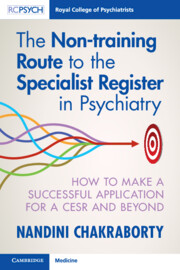 The Non-training Route to the Specialist Register in Psychiatry
The Non-training Route to the Specialist Register in Psychiatry Book contents
- The Non-training Route to the Specialist Register in Psychiatry
- The Non-training Route to the Specialist Register in Psychiatry
- Copyright page
- Dedication
- Contents
- Foreword
- Acknowledgements
- Author’s Note
- Introduction
- 1 The Stages of Application
- 2 CESR Statistics for Psychiatry
- 3 The CESR Portfolio: Introduction
- 4 The CESR Portfolio: Adult Psychiatry
- 5 The CESR Portfolio: Old Age Psychiatry
- 6 The CESR Portfolio: CAMHS Psychiatry
- 7 The CESR Portfolio: Medical Psychotherapy
- 8 The CESR Portfolio: Forensic Psychiatry
- 9 The CESR Portfolio: Intellectual Disability Psychiatry
- 10 Additional Tips for the CESR Portfolio Evidence
- 11 Non-CCT CESR
- 12 Completing Your Application
- 13 Examples from CESR Applications: What Do Evaluators Look Out For
- 14 CESR Journeys: Personal Stories of Struggles and Achievements
- Afterword
- Book part
- Further Resources
- Index
- References
Introduction
Published online by Cambridge University Press: 27 July 2023
- The Non-training Route to the Specialist Register in Psychiatry
- The Non-training Route to the Specialist Register in Psychiatry
- Copyright page
- Dedication
- Contents
- Foreword
- Acknowledgements
- Author’s Note
- Introduction
- 1 The Stages of Application
- 2 CESR Statistics for Psychiatry
- 3 The CESR Portfolio: Introduction
- 4 The CESR Portfolio: Adult Psychiatry
- 5 The CESR Portfolio: Old Age Psychiatry
- 6 The CESR Portfolio: CAMHS Psychiatry
- 7 The CESR Portfolio: Medical Psychotherapy
- 8 The CESR Portfolio: Forensic Psychiatry
- 9 The CESR Portfolio: Intellectual Disability Psychiatry
- 10 Additional Tips for the CESR Portfolio Evidence
- 11 Non-CCT CESR
- 12 Completing Your Application
- 13 Examples from CESR Applications: What Do Evaluators Look Out For
- 14 CESR Journeys: Personal Stories of Struggles and Achievements
- Afterword
- Book part
- Further Resources
- Index
- References
Summary
The Specialist Register was created on 12 January 1996 under the provisions of the European Specialist Medical Qualifications Order 1995 (the 1995 Order). Among other things, the 1995 Order made it a condition that any doctor who wished to take up a consultant post in the National Health Service (NHS) after 1 January 1997 would need to be included in the Specialist Register, although it did not compel those already holding a consultant post in the NHS to obtain specialist registration.
- Type
- Chapter
- Information
- The Non-training Route to the Specialist Register in PsychiatryHow to Make a Successful Application for a CESR and Beyond, pp. 1 - 4Publisher: Cambridge University PressPrint publication year: 2023


